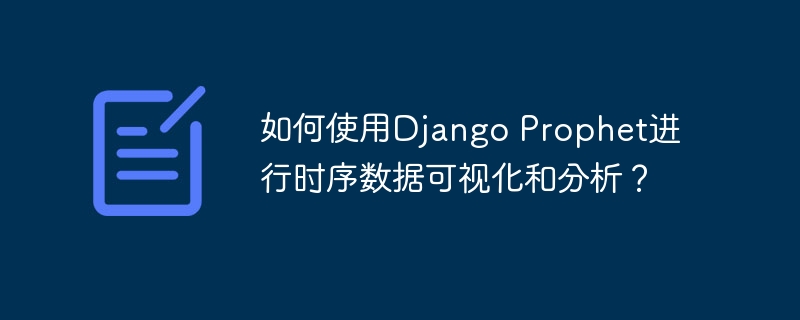Home >Backend Development >Python Tutorial >How to use Django Prophet for time series data visualization and analysis?
How to use Django Prophet for time series data visualization and analysis?
- 王林Original
- 2023-09-26 22:46:503515browse

How to use Django Prophet for time series data visualization and analysis?
Time series data is a very common type of data in our lives, such as stock prices, temperatures, website visits, etc. For the analysis and prediction of time series data, we can use some powerful tools to help us achieve it. One of the very popular tools is Facebook's open source Prophet. Prophet is an open source tool for time series analysis and prediction. It is based on statistical analysis and machine learning methods and can help us visualize and analyze time series data more conveniently.
In this article, we will introduce how to use Django Prophet for visualization and analysis of time series data. Django Prophet is an extension that integrates Prophet into the Django framework. It provides some convenient APIs and functions, making it easier for us to use Prophet in Django projects for time series data analysis and prediction.
First, we need to install Django Prophet. We can use the pip command to install it:
pip install django-prophet
After the installation is complete, we need to add 'django_prophet' to INSTALLED_APPS in the settings.py file.
Next, we can create a Django model to store our time series data. Suppose we want to store daily website visits, we can create a model called PageViews:
from django.db import models
class PageViews(models.Model):
date = models.DateField()
views = models.IntegerField()Then, we can use the command line tool provided by Django Prophet to import the data.
python manage.py import_prophet_data --model=app_name.PageViews --date-col=date --value-col=views --input-file=path/to/data.csv
This will import the data from the CSV file into our model.
Next, we can use Django Prophet in our view to analyze and predict time series data. Suppose we have a view called PageViewsView where we can use the API provided by Django Prophet for analysis and prediction.
from django_prophet import Prophet
class PageViewsView(View):
def get(self, request, *args, **kwargs):
# 获取所有的PageViews数据
page_views = PageViews.objects.all()
# 创建一个Prophet对象
prophet = Prophet()
# 将数据加载到Prophet中
prophet.load_data(page_views)
# 进行时序数据的分析和预测
prophet.fit()
# 获取分析结果和预测值
analysis = prophet.get_analysis()
predictions = prophet.predict()
# 将分析结果和预测值传递给模板进行展示
return render(request, 'page_views.html', {'analysis': analysis, 'predictions': predictions})In the template, we can use Django's template syntax to display analysis results and predicted values.
This is just a simple example, you can use Django Prophet for more complex and in-depth time series data analysis and prediction according to your own needs. Django Prophet provides more APIs and functions, such as adjusting model parameters, obtaining component decomposition results, and more.
To sum up, it is very convenient and simple to use Django Prophet to visualize and analyze time series data. By integrating Prophet into the Django framework, we can more easily use the powerful Prophet tool to analyze and predict our time series data. I hope this article is helpful to you, and I wish you success on the road to time series data analysis!
The above is the detailed content of How to use Django Prophet for time series data visualization and analysis?. For more information, please follow other related articles on the PHP Chinese website!
Related articles
See more- Introduction to how Django uses Social-Auth to implement QR code login on WeChat third-party websites
- Detailed explanation of the steps for django to display background table data in the front-end html page
- The difference between django and apache
- How to use Django Prophet for website traffic prediction and optimization?
- Integration of Django Prophet and machine learning: How to use time series algorithms to improve forecast accuracy?

